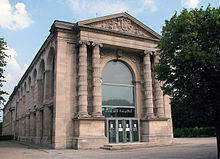National Gallery of Jeu de Paume
The Galerie nationale du Jeu de Paume ( Jeu de Paume for short ) is a museum for contemporary art in the 1st arrondissement of Paris .
The building was built in 1861 under Napoléon III. built and initially used as a sports hall for the Jeu de Paume ball game . From 1909 the rooms were used for the collection of art. Today they are the location for exhibitions of contemporary photography and video art .
location
The Galerie nationale du Jeu de Paume is located in the northwest of the Tuileries Gardens on the Place de la Concorde . It stands on the along the Rue de Rivoli current terrace of the Feuillants .
building
history
The building was built in 1861 under the Napoleon III government . built by the architect Viraut. It was equipped with playing fields for the Jeu de Paume , a forerunner of tennis .
The former ballroom has been dedicated to art since 1909 . Alongside the Louvre and the Musée de l'Orangerie opposite, it is the third museum in the Tuileries Gardens.
During the Second World War , the museum served the German occupiers as a transshipment point for stolen works of art . The National Socialists confiscated works of art that were owned by Jews and brought them to the Jeu de Paume to be inventoried and cataloged so that high officials could choose pictures for their own use. The pictures were then brought to Germany. The Nazis also confiscated modern art and pictures by Jewish artists, which they described as degenerate , and stored them in the Jeu de Paume Museum. They used these images as commodities to trade in for images that they thought were acceptable. What was left was destroyed by the Nazis before they left.

During the occupation, the French curator Rose Valland worked in the museum. She had ties to the Resistance and kept a record of the details of the art theft. After the war she was able to help solve the crimes.
From 1947 until the opening of the Musée d'Orsay in 1986, the museum was called Galerie du Jeu de Paume . Works by Impressionists were exhibited.
At the initiative of the Minister of Culture, Jack Lang , the gallery reopened as the Galerie nationale du Jeu de Paume , an exhibition space for modern and contemporary art, at the beginning of the nineties following expansion work under the direction of Antoine Stinco . Since 2004 she has dedicated herself exclusively to contemporary photography and video art .
Dimensions
- Length and width: 80 × 13 m
- Usable area: 2,754.50 m²
- Exhibition space: 1137 m²
- Nine halls on three levels
- With a wall length of 420 m
- Clear height of most of the halls: 4.50 m ^
Exhibitions (selection)
Solo exhibitions
- 2004: Nuremberg: Les coulisses du pouvoir , photographs by Arno Gisinger
- 2004: Rineke Dijkstra
- 2005: Jean-Luc Moulène ,
- 2005: Tony Oursler : Dispositifs
- 2005: Michal Rovner : Fields
- 2006: Craigie Horsfield
- 2006: Ed Ruscha :
- 2006: Cindy Sherman : Retrospective
- 2006: Friedlander
- 2007: Pierre et Gilles : Double je - 1976-2007
- 2007: Steichen : Une épopée photographique
- 2008: Eija-Liisa Ahtila
- 2008: Alec Soth : Mississippi & Niagara
- 2008: Richard Avedon
- 2010: William Kentridge : Cinq Thèmes
Thematic or collective exhibitions
- 2004: L'Ombre du temps: Documents et expérimentations dans la photographie du XXe siècle
- 2005: Burlesques contemporains
- 2005: Chaplin et les images
- 2005: Croiser des mondes , Aspects du document contemporain
- 2007: L'Événement , les images comme acteurs de l'histoire
Web links
Coordinates: 48 ° 51 ′ 57 " N , 2 ° 19 ′ 26" E




